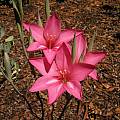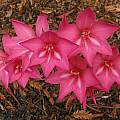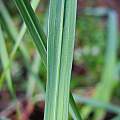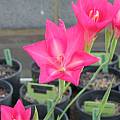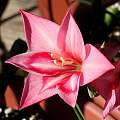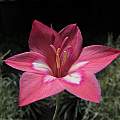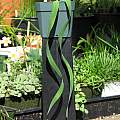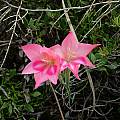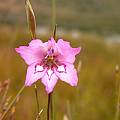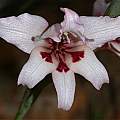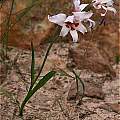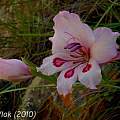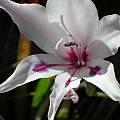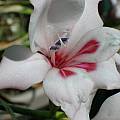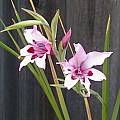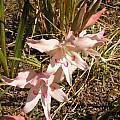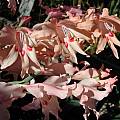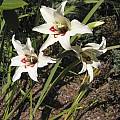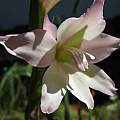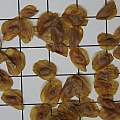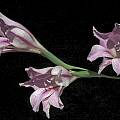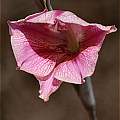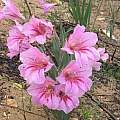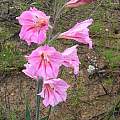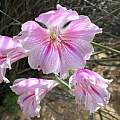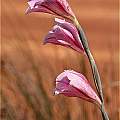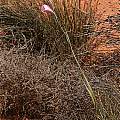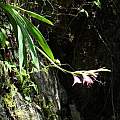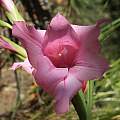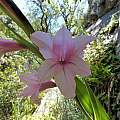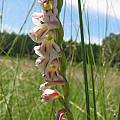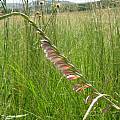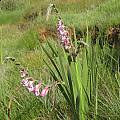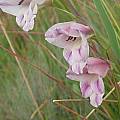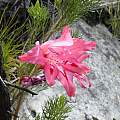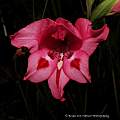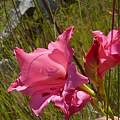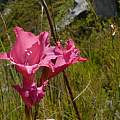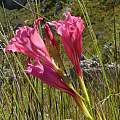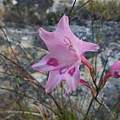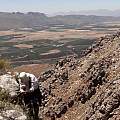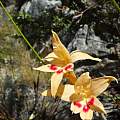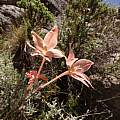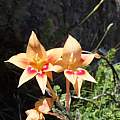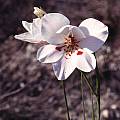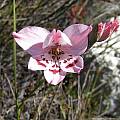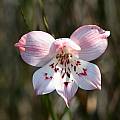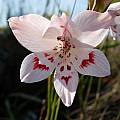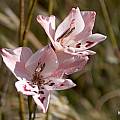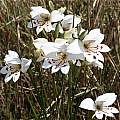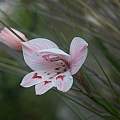From pale rose and mauve to salmon to screaming pink, this color complex offers many shades and the widest range of species in the color indices.
Page 1: G. anatolicus... Page 3: G. densiflorus... Page 4: G. gracilis... Page 5: G. maculatus... Page 6: G. nigromontanus... Page 7: G. phoenix... Page 8: G. saxatilis... Page 9: G. vernus...
Gladiolus carmineus is a narrow endemic of the southwestern Cape coast (winter rainfall) where it grows on rocky sandstone cliffs within the sight of the sea. Flowers appear in the fall (mid February to April) and are pale to deep pink. Each of the lower three tepals and sometimes the upper lateral tepals have a median whitish streak surrounded by a pale mauve halo. There are three to five reduced leaves on the flowering stem. Foliage leaves produced by plants that did not flower appear later and are long and trailing, 8 to 10 mm wide, glaucous with a lightly thickened midrib. They grow during the wet winter and spring, drying off in late spring.
Some PBS members report that they get better results from this bulb in pots if watering is started in late summer (August in California). Others report that it blooms reliably in dry ground even if given no supplemental water. You may need to experiment to see what works best in your climate. It is definitely easier to grow in coastal climates. It has naturalized in the coastal Northern California garden of Bob Rutemoeller and Mary Sue Ittner. They scatter seeds about after the pods split open. The first four photos were taken in this garden. The third shows the long narrow foliage leaves of a clump in February 2014. The fourth is a closer view of a leaf. Mary Sue was asked why these leaves look different from the ones in Nhu's photo below. She did a tour of her garden and found leaves of different widths, some curled, some upright, and some flat. So it may depend on how and where the plants are growing, as well as how old they are. Photo 5 was taken in September, 2005 by David Victor, which flowers in the UK during September, followed later by the foliage. Flower stems and foliage are grey-green. David's plants hold typically four or five flowers on a spike. The last photo is from the summer hemisphere and was taken by Bill Dijk.
Photo 1 is of a slightly lighter-colored form grown by Michael Mace. Photos 2-3 were taken by Nhu Nguyen. Photo 3 shows the pendent habit of the leaves, which makes sense since it grows on cliffs.
Photos taken in habitat near Hermanus, South Africa by Cameron McMaster.
Gladiolus carneus F.Delaroche (syn. G. blandus Aiton ) has a wide distribution in the winter rainfall area of southern Africa and is found in a variety of habitats. It is a variable species that grows to about 50 cm with white to pink large flowers usually with dark spade shaped markings on the three lower lobes. It flowers late spring. This one seeds set very easily and also increases by cormlets. Photos taken in the wild, the first by Cameron McMaster in the Overberg and photos two and three by Andrew Harvie in Table Mountain National Park. Photo four is from the book Plants of the Klein Karoo courtesy of Jan and Anne Lise Schutte-Vlok. The last two photos are close-ups taken by Alan Horstmann.
The first photo was taken by Doug Westfall. The second one was taken June 2003 in Northern California of plants grown from seed, photo by Mary Sue Ittner. The third photo was taken by Jana Ulmer of plants grown from the same seed batch as the picture above. In 2004 both her population and Mary Sue's produced a lot of flowers that bloomed a very long time. Another form has been a reliable bloomer in our Northern California garden where it is planted in the ground and returns each year. Photo four by Bob Rutemoeller. Fifth photo is of an unmarked form, by Gordon Summerfield. Photo of seed on a 10 mm grid by David Pilling
Gladiolus caryophyllaceus (Burm.f.) Poir. grows on sandstone flats and slopes in the winter rainfall area, flowers winter to spring, and has large pink to mauve flowers that are speckled on the lower tepals and fragrant. This species has naturalized in Western Australia. The first four photos by Mary Sue Ittner, Bob Werra, and Alan Horstmann.
The first four habitat shots from Alan Horstmann were taken in the Western Cape. The last two habitat shots by Andrew Harvie were taken east of Koebeeberge in the Western Cape.
Gladiolus cataractarum is a rare endemic of the southern African summer rainfall region. Plants grow on cliffs and steep rocky slopes on quartzite in sheltered, south facing sites. Growing to 70 cm high, this species has eight to nine lanceolate leaves of different sizes and pink unscented flowers with the lower three tepals marked with reddish longitudinal lines. The first photo of the plant in habitat taken by Rod Saunders. Flower photos from Rachel Saunders. They had to walk up a gully to reach it and found it difficult to photograph hanging off the cliff.
Gladiolus crassifolius Baker (syn. G. rachidiflorus, G. thomsonii, G. masukuensis, G. mosambicensis, G. tritoniiformis, G. junodii, G. coranthii, G. gazensis, G. dieterlenii) is a widespread species of eastern southern Africa. It is found also in tropical Africa. Plants in southern Africa usually grow in hilly country in well-drained rocky grassland habitats and bloom late summer. Plants in tropical Africa bloom earlier before the new season’s leaves have developed. Flowers are borne in a 16 to 22 flowered spike and are usually pale to deep pink or light purple. The lower lateral tepals have a dark band of color across the lower half of the limbs. Photos taken by Cameron McMaster at Maclear and Sentinel Peak in the Eastern Cape in 2008.
Gladiolus crispulatus L. Bolus is a rare endemic that is found in the Southwestern Cape on south facing slopes between Swellendam and Riversdale. Growing to 30-40 cm, it has four or five superposed leaves, with the midribs lightly thickened and usually paired on one side and single on the other, and deep pink flowers with triangular median streaks and dark spots in the throat. It is similar to Gladiolus oreocharis but has larger flowers and different leaves and to Gladiolus carneus which also has different leaves and tepal markings. If flowers November-December, but usually only in the first several years after a fire so is rarely seen. The first photograph from Rachel Saunders was taken close to the top of the Langeberg Mountains. The next photos from iNaturalist were taken by Brian du Preez in November in the Western Cape and lennartn in November near Swellendam and shared under CC BY-SA and CC BY-NC licenses.
Gladiolus cylindraceus G.J.Lewis grows on rocky sandstone slopes and ridges in low fynbos vegetation at elevations above 1500 m in the Ceres District of the Southwest Cape. Growing to 50 cm, it has three distinctive linear leaves with the lower one or two basal and the lowermost reaching to between the base and apex of the spike, sheathing the stem and cross shaped in transverse with wide grooves. The unscented flowers are pale pink to salmon with a diamond shaped red mark sometimes with a white to yellow center on the lower tepals. The tube is slender and elongate, up to 52 mm long. It flowers December to January. Photos from Rod Saunders and Rachel Saunders. The first was taken on the Waboomsberg Mountain and the others in the Witsenberg Mountains where there were flowers in colors from pink to apricot to almost yellow.
Gladiolus debilis Ker Gawler is found on rocky sandstone slopes in the southwest Cape, blooming in spring with white to pale pink flowers with red markings on the lower tepals. The first photo by Mary Sue Ittner was taken in September 2001 in an area in the southwest Cape that had burned the year previously and the second was taken by Bob Rutemoeller September 2003 at Boskloof. The third was taken by Ragnhild Crawford. Photos four and five taken near Napier in the Overberg by Cameron McMaster. The sixth photo was taken by Andrew Harvie at Silvermine in Table Mountain National Park. Last photo by Christopher Whitehouse, taken at the Phillpskop Mountain Reserve near Stanford.
Page 1: G. anatolicus... Page 3: G. densiflorus... Page 4: G. gracilis... Page 5: G. maculatus... Page 6: G. nigromontanus... Page 7: G. phoenix... Page 8: G. saxatilis... Page 9: G. vernus...
